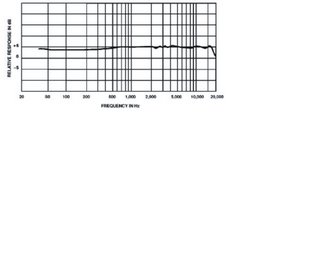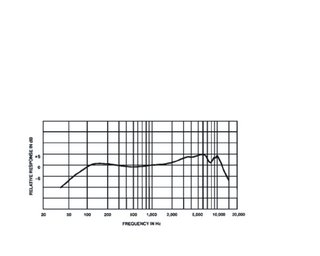There is no inherent advantage in fidelity of one type of microphone over another. Condenser types require batteries or power from the mixing console to operate, which is occasionally a hassle, and dynamics require shielding from stray magnetic fields, which makes them a bit heavy sometmes, but very fine microphones are available of both styles. The most important factor in choosing a microphone is how it sounds in the required application.
The frequency response of a microphone is defined by the range of sound (from lowest to highest frequency) that it can reproduce, and by its variation in output within that range. It is the frequency response that determines the basic “sound” of the microphone.
The two general types of frequency response are flat and shaped. These terms refer to the graphical representation of frequency response or response curve. A microphone that provides a uniform output at every audible frequency is represented on a frequency response graph as an even, flat line, and is said to have a flat response. This means that the microphone reproduces all of the sound within its frequency range with little or no variation from the original sound. In addition, flat response microphones typically have an extended frequency range; that is, they can reproduce very high and/or very low frequencies as well. Widerange, flat response microphones have a natural, highfidelity, “uncolored” sound.
Flat Frequency Response
A flat frequency response has been the main goal of microphone companies for the last three or four decades. In the fifties, mics were so bad that console manufacturers began adding equalizers to each input to compensate. This effort has now paid off to the point were most professional microphones are respectably flat, at least for sounds originating in front. The major exceptions are mics with deliberate emphasis at certain frequencies that are useful for some applications. This is another part of the microphone mystique. Problems in frequency response are mostly encountered with sounds originating behind the mic.
By contrast, a shaped microphone response will appear on a frequency response graph as a varying line with specific peaks and dips. This shows that the microphone is more sensitive to certain frequencies than to others, and often has a limited frequency range. A shaped response is usually designed to enhance the sound of a particular source in a particular application, while at the same time minimizing the pickup of certain unwanted sounds. Shaped response microphones each have a “characteristic” sound.
Shaped Frequency Response
The selection of a flat or shaped response microphone involves consideration of both the sound source and the sound destination. The frequency range of the microphone must be wide enough to pick up the desired range of the sound source. This range must also be appropriate to the intended destination of the sound: that is, wider range for high-quality sound systems or recording/broadcast systems, narrower range for speechonly public address systems. Within its range the microphone should respond in such a way that the sound is reproduced either with no change (flat response) or with changes that enhance the sound in some desirable manner (shaped response). 
Normally, microphones with flat, wide-range response are recommended for high-quality pickup of acoustic instruments, choral groups and orchestras, especially when they must be placed at some distance from the sound source. Flat response microphones are less prone to feedback in high gain, distant pickup applications because they do not have frequency response peaks that might trigger feedback at any specific frequency. The most common shaped response is for vocal use. Typically, this consists of limiting the range to that of the human voice and adding an upper mid-range response rise. Such a “presence rise”, coupled with controlled low- and high-frequency response can give a sound with improved vocal clarity. This is especially true for lapel or lavalier microphones. The pickup of certain instruments such as drums and guitar amplifiers may also benefit from a shaped response microphone. Finally, the frequency response of some microphones is adjustable, typically by means of switches, to tailor the microphone to different applications. Most common are low-frequency rolloff controls, which can help prevent “rumble”, and presence rise switches to enhance
intelligibility.
Articles about Microphone, Mixer, Amplifier, Speaker, Sound Reinforcement, Audio Installation, Broadcast, Recording
Frequency Response of Microphones ~ Famers Audio: Articles about Audio, Acoustics and Sound
Microphone - Mixer - Amplifier - Speaker - Sound Reinforcement - Audio Installation - Broadcast - Recording
